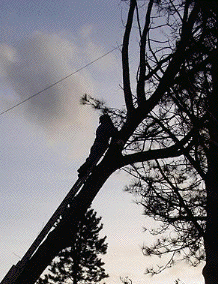Removing Trees from
the Bottom Up
Removing Trees from the Top Down
Removing Trees at Ground Level Removing Multiple Trees
A leaning tree is one of the
most challenging to remove. It is not called a widow-maker for
nothing. This 80 foot oak uprooted and fell into a ponderosa pine.
 |
The best way to remove a
leaning tree is to call a professional. We did, but he had a
stroke the day before he was going to take this tree out.
I first cut off three large
branches to keep the weight of the oak centered on the pine.
It is too risky (for me) to take a chain saw up more than 15
feet, so I used a bow saw here. I attached a pole to the bow
saw with duct tape to increase
its reach.
I cut the vertical branch
above part way through and then pulled it over with my truck
and a 100 foot steel cable, 10 feet above the rope in the picture
for leverage. Click here
to see how to attach a rope or cable well beyond your reach.
|
Large rhododendrons filled
the space under the leaning tree, so I decided to take it out
a few feet at a time from the bottom up. I began by cutting a
shallow angle from the front of the trunk, and then a steeper
angle from

the back. Then I put wedges
in each side, half way up the back cut. A few chops with an ax
broke the hold, and the tree slid forward and down several feet.
Next, I made front and back cuts perpendicular to the trunk at
the four foot level. Then I repeated the steep angle cuts and
dropped the tree another four feet. By angling the cuts to the
side, you can move the tree sideways around plants. Steep cuts
increase the lean of the tree, perpendicular cuts decrease it.
Thus, you can control its path as it gets shorter.
Eventually, the oak slid down
the ponderosa to the point where I could remove all its branches
from the ground. It never actually fell, and there was only minimal
damage to the rhododendrons.
Click here
to see the chair made from this tree.


